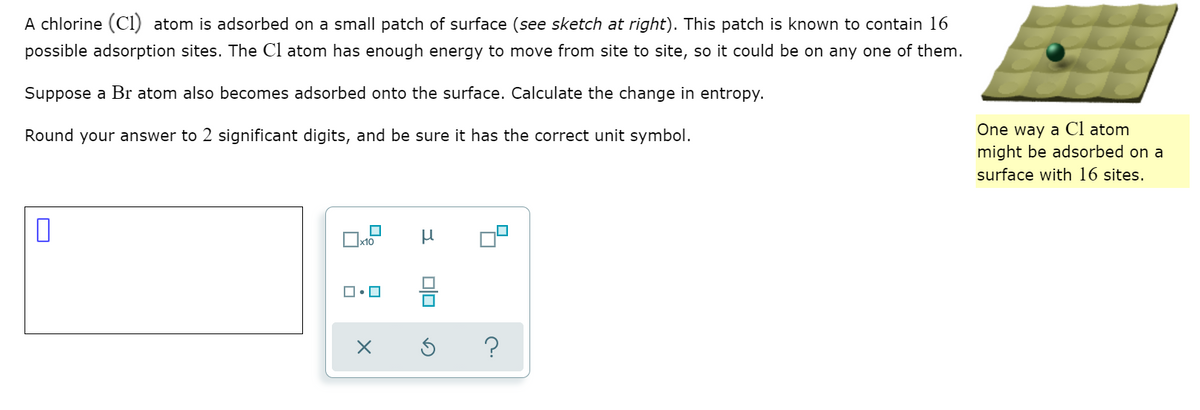A chlorine (Cl) atom is adsorbed on a small patch of surface (see sketch at right). This patch is known to contain 16 possible adsorption sites. The Cl atom has enough energy to move from site to site, so it could be on any one of them. Suppose a Br atom also becomes adsorbed onto the surface. Calculate the change in entropy. Round your answer to 2 significant digits, and be sure it has the correct unit symbol. One way a Cl atom might be adsorbed on a surface with 16 sites.
A chlorine (Cl) atom is adsorbed on a small patch of surface (see sketch at right). This patch is known to contain 16 possible adsorption sites. The Cl atom has enough energy to move from site to site, so it could be on any one of them. Suppose a Br atom also becomes adsorbed onto the surface. Calculate the change in entropy. Round your answer to 2 significant digits, and be sure it has the correct unit symbol. One way a Cl atom might be adsorbed on a surface with 16 sites.
Chemistry by OpenStax (2015-05-04)
1st Edition
ISBN:9781938168390
Author:Klaus Theopold, Richard H Langley, Paul Flowers, William R. Robinson, Mark Blaser
Publisher:Klaus Theopold, Richard H Langley, Paul Flowers, William R. Robinson, Mark Blaser
Chapter16: Thermodynamics
Section: Chapter Questions
Problem 10E: Consider the system shown in Figure 16.9. What is the change in entropy for the process where the...
Related questions
Question

Transcribed Image Text:A chlorine (CI) atom is adsorbed on a small patch of surface (see sketch at right). This patch is known to contain 16
possible adsorption sites. The Cl atom has enough energy to move from site to site, so it could be on any one of them.
Suppose a Br atom also becomes adsorbed onto the surface. Calculate the change in entropy.
One way a Cl atom
might be adsorbed on a
Round your answer to 2 significant digits, and be sure it has the correct unit symbol.
surface with 16 sites.
olo
Expert Solution
This question has been solved!
Explore an expertly crafted, step-by-step solution for a thorough understanding of key concepts.
This is a popular solution!
Trending now
This is a popular solution!
Step by step
Solved in 3 steps

Knowledge Booster
Learn more about
Need a deep-dive on the concept behind this application? Look no further. Learn more about this topic, chemistry and related others by exploring similar questions and additional content below.Recommended textbooks for you

Chemistry by OpenStax (2015-05-04)
Chemistry
ISBN:
9781938168390
Author:
Klaus Theopold, Richard H Langley, Paul Flowers, William R. Robinson, Mark Blaser
Publisher:
OpenStax

Chemistry for Engineering Students
Chemistry
ISBN:
9781285199023
Author:
Lawrence S. Brown, Tom Holme
Publisher:
Cengage Learning

Physical Chemistry
Chemistry
ISBN:
9781133958437
Author:
Ball, David W. (david Warren), BAER, Tomas
Publisher:
Wadsworth Cengage Learning,

Chemistry by OpenStax (2015-05-04)
Chemistry
ISBN:
9781938168390
Author:
Klaus Theopold, Richard H Langley, Paul Flowers, William R. Robinson, Mark Blaser
Publisher:
OpenStax

Chemistry for Engineering Students
Chemistry
ISBN:
9781285199023
Author:
Lawrence S. Brown, Tom Holme
Publisher:
Cengage Learning

Physical Chemistry
Chemistry
ISBN:
9781133958437
Author:
Ball, David W. (david Warren), BAER, Tomas
Publisher:
Wadsworth Cengage Learning,

Chemistry: The Molecular Science
Chemistry
ISBN:
9781285199047
Author:
John W. Moore, Conrad L. Stanitski
Publisher:
Cengage Learning

Chemistry for Today: General, Organic, and Bioche…
Chemistry
ISBN:
9781305960060
Author:
Spencer L. Seager, Michael R. Slabaugh, Maren S. Hansen
Publisher:
Cengage Learning